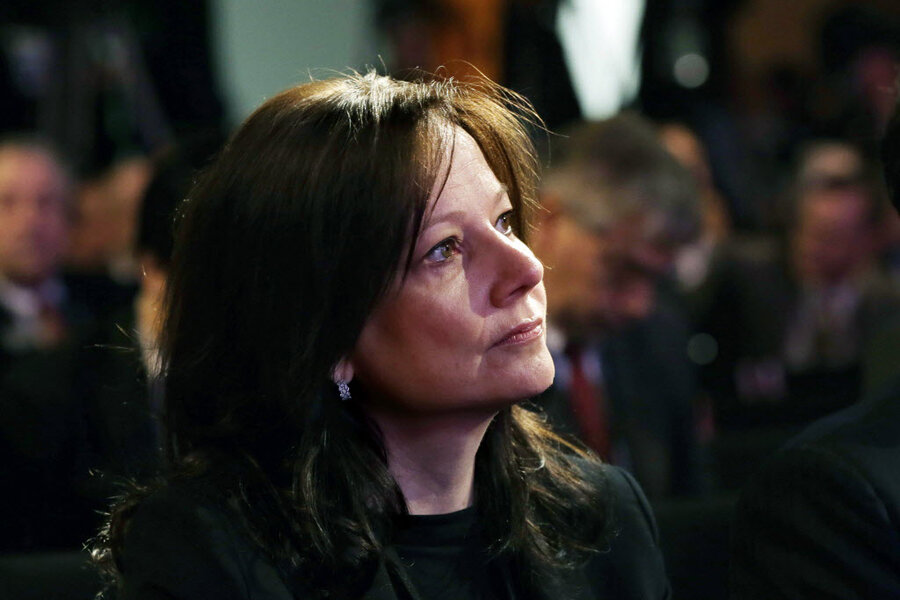For Mary Barra, ascent to top of GM started on the factory floor
Loading...
In taking the helm of General Motors on Tuesday, Mary Barra becomes the first woman to serve as chief executive officer of a major automotive company, a sign that corporate boards and investors increasingly see leaders' gender as a nonissue and gender diversity perhaps even as an asset.
Ms. Barra, who started at the company in 1980 when she was a student intern on the factory floor, rose through the ranks to play several important roles at GM, including vice president of global manufacturing engineering, head of the Hamtramck Assembly plant, executive director of competitive operations engineering, and its first chief of global product development. Most recently, she led vehicle development operations, strengthening some of GM's best-known brands and pushing for greater emphasis on fuel-efficient technology.
Her biggest supporter is said to be outgoing CEO Dan Akerson. In September, Mr. Akerson told attendees at a Detroit conference on leadership that “the Detroit Three are all run by non-car guys. Someday, there will be a Detroit Three that’s run by a car gal.” He hinted at Barra’s appointment, saying, “There are an unbelievable number of talented women in automotive, certainly at General Motors.”
In October, he told Reuters that Barra is “one of the best talents I’ve seen in my working career – not GM, my working career.”
She joins a growing corps of female CEOs at other global corporations, including Virginia "Ginni" Rometty at International Business Machines Corp., Indra Nooyi at PepsiCo Inc., Marissa Mayer at Yahoo! Inc., and Ursula Burns of Xerox Corp.
Of course, women remain vastly underrepresented in top management roles at global corporations. They represent 4.2 percent of Fortune 500 CEO positions and 4.5 percent of Fortune 1000 CEO positions. Meg Whitman, CEO of Hewlitt-Packard, is the top-ranking woman on both lists of corporate profitability, but she sits in the No. 15 position for CEOs overall.
Corporations have “not arrived at a tipping point” to reverse this disparity, says Dana Ardi, an executive management expert based in New York. But the corporate world is entering “an age of mindfulness on behalf of boards of directors that the talent pool is comprised of both men and women and we need the best athletes to control our next-generation businesses.”
Ms. Ardi, author of “The Fall of the Alphas: The New Beta Way to Connect, Collaborate, Influence – and Lead,” says the reason women haven’t filled these roles as plentifully as many had hoped is because corporate culture has generally discouraged women from advancing to the very top ranks.
“They haven’t been nurtured and they haven’t been sponsored to step up. We need to clear that path and empower them,” she says. A way to do that: Strong, well-formulated talent development programs are needed for employees of both genders, she says.
Kathy Kram, a professor at the Boston University School of Management and an authority on gender and leadership, agrees that “competent and ambitious women have been in the pipeline long enough to have them surfacing as viable candidates for the CEO role.” Even so, she says, it does not happen often enough.
And when it does, women CEOs often “fall prey to excessive scrutiny,” Ms. Kram warns, pointing to former Hewlett-Packard CEO Carly Fiorina, the first woman to run a Fortune 20 company. Ms. Fiorina was forced to resign her position in 2005.
“Because [Barra] is so visible as the first female CEO of GM,” the resulting scrutiny “would not be helpful to her, for the company, or for those of us who want to see more diversity in the C-suite,” Kram says.
Barra’s position at GM is especially unusual not only because she is running the largest automotive company in America, but also because top management in the industry traditionally skews so male.
Michelle Krebs, a senior analyst with Edmunds.com, says performance is what made Barra the best candidate, not “filling a female quota.”
“I never thought I’d see the day that a woman would head a car company,” Ms. Krebs says. “Mary is an extremely competent automotive executive who has proven herself repeatedly. She came up through the manufacturing ranks – a difficult way to climb the corporate ladder for anyone, but especially for women.”
Barra is known as a consensus-builder, rather than relying on a top-down management style. In her different roles, she instituted team-building efforts and “hall meetings” to seek outside advice on projects as a way to challenge design and engineering leaders to reexamine their assumptions. She also restructured some traditional GM processes so that decisions about key projects were made early and not prolonged.
“Too often in the past, we would waste time and energy by doing business with ourselves. My style is to have a rigorous debate before we start on something. 'Is it in or is it out? What are the most important products to invest in?' And then we just go,” she told Automotive News in March.
She also pushed GM to make practical, gas-sipping cars that also boast a sleek design. In 2011, she pressed the company to fund the development of a full line of fuel-efficient engines. Some of the vehicles she successfully shepherded are the Cadillac ELR plug-in hybrid and the revamped Chevrolet Impala.
Barra enters GM on the heels of the Obama administration's announcement that the US Treasury is selling its remaining shares of the company, acquired as a result of the company's 2009 controlled bankruptcy and structuring. GM emerged with reduced debt and fewer automotive brands.
Akerson, GM’s CEO since 2010, is retiring to spend time with his wife, who has been diagnosed with a grave illness. In a statement to employees this week, he said he is exiting GM “with great satisfaction in what we have accomplished, great optimism over what is ahead, and great pride that we are restoring General Motors as America’s standard-bearer in the global auto industry.”








